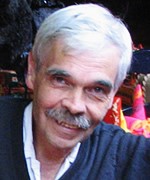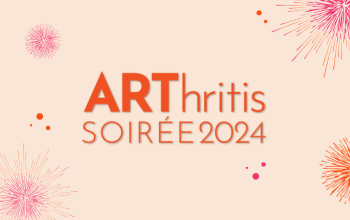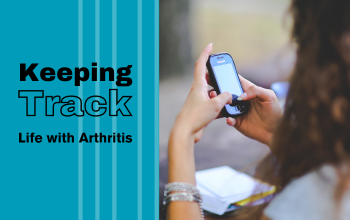Living with Ankylosing Spondylitis
By Gerry Sheanh
I have lived with ankylosing spondylitis (AS) all of my adult life. It has at times been burdensome and, at others, just a minor irritant. The most obvious sign of the disease is that my neck is wholly fused, as are my lower lumbar vertebrae. I have long since made my peace with the disease, although I know I miss a lot because I can’t move my head. Sometimes I think that people must think I am rude when they approach me from outside my field of vision, and I don’t turn to face them with my reply. This is also why I always choose to sit at the end of a long meeting table. It is not that I think myself important, but that I can see everyone without having to turn my body to speak to the person next to me. Spinal fusion forces you to adapt.
The onset of my journey with AS came at seventeen, and as a result of a painful encounter with a steel bar that I was slammed into during a barbaric game called murderball. After that I began having low back pain that radiated down my leg. Physiotherapy and exercise moderated the pain but when I became tired, it always seemed to ache more. I wasn’t diagnosed until I was about twenty-eight, when a wise old doctor recognized something he had seen in young British soldiers. He sent me off to an internist and after sundry tests and x-rays, I was told I had AS. Great, I thought. And what exactly did that mean?
Through many years of waves of doubt and swirls of denial, I managed to cope with the aid of Indomethacin (also known as Indocid) even though it was hell on my stomach. Meanwhile, my physical world was shrinking. I was never a great skier, but I enjoyed challenging myself on the slopes. When I became fearful of falling and breaking my fused neck, I knew I couldn’t risk it. I played hockey three times a week in a rec league, but I began to be tentative in my play and knew it was time to stop.
Elizabeth Kubler-Ross did some groundbreaking research in the late 1970’s on the stages of loss. According to the good doctor, all humans go through recognizable stages following the loss of something or someone dear to them. The stages have no particular order except for the fifth, which is acceptance. Before that, however, we go through grief, denial, bargaining and anger. Having lost the physically active part of my being, I went through all of them.
The grief was an intense sadness that I couldn’t ski or skate anymore. It still visits me from time to time. I was in denial for the longest time, thinking that if I kept myself in good enough shape, I could do anything. But I couldn’t. In bargaining with myself, it sounded like this: If I switched to defense and stayed away from any contact, maybe I could play. Then I remembered I didn’t know how to play defense. And yes I was angry, but not at anything in particular. Instead it was a simmering, generalized anger that I mostly suppressed, with varying levels of success. I was difficult to live with at times.
I finally arrived at acceptance, and that took a life-altering twenty-four days on the Arthritis Ward of G.F. Strong Rehabilitative Hospital. My rheumatologist had referred me and when I arrived there on a blustery February day, I was feeling about as low as I ever had. I had switched from Indomethacin to Diclofenac. It is fair to say that if Indomethacin was artillery, Diclofenac was a cap pistol.
In the hospital I had three physical therapy sessions a day. I had consultations with a social worker, a pharmacist, a nutritionist, a physical therapist, an occupational therapist, a rheumatologist and various nurses. They employed a team approach and there were weekly meetings with the patient and the team. More than all of this enormous effort at putting me back together was the fact that, for the first time in my life, I met other people with AS. I was surprised that they seemed to be suffering in different ways than I was, but I learned that all of them could trace their own onsets to a physical injury. One gentleman had the use of only one wrist and hand, which he used to navigate his wheelchair. His courage and good humour reminded me that for as bad as I sometimes felt, somebody else had it worse, and endured without complaint.
After three and a half weeks I returned home feeling far better than I had when I left. It took a couple of months for me to get my working life back to the breakneck pace I had always set for myself. More important, I was on a new medication called Vioxx. For me it was the silver bullet that made all the pain go away and carried no apparent side effects. Except that others had experienced heart issues that were potentially fatal. Vioxx was withdrawn to the collective howls of protest from other believers in the silver bullet. I think I went on Celebrex after that, which was better than Diclofenac but about a tenth as effective as Vioxx. And then, God created biologics.
My rheumatologist completed all the necessary paperwork for me to begin a course of Enbrel treatment. The ways in which biologics work is difficult to fully grasp for most of us, but the net effect of Enbrel is that it reduces inflammation in the joints. It does this by reducing the naturally occurring substance that results in increased inflammation in people with immune system issues, such as all inflammatory arthritis patients. For me, Enbrel is all I could have hoped for, but there are other biologics that may be as or more effective for different people.
I have now begun a new phase of my life with AS. I have become a volunteer member of the Consumer’s Advisory Board of the Arthritis Research Centre of Canada. The Board is comprised of active, creative, thoughtful and dedicated people, and all of them live with some form of arthritis. It is my hope that I can share whatever I have learned about AS in particular and arthritis in general. I have lived with this disease forever and gradually came to realize that you can choose to be a victim, or you can choose to adapt. Perhaps it might be that the degree to which we are happy or content depends largely on our willingness and ability to adapt. In any event, it works for me, though your mileage may vary.






















































